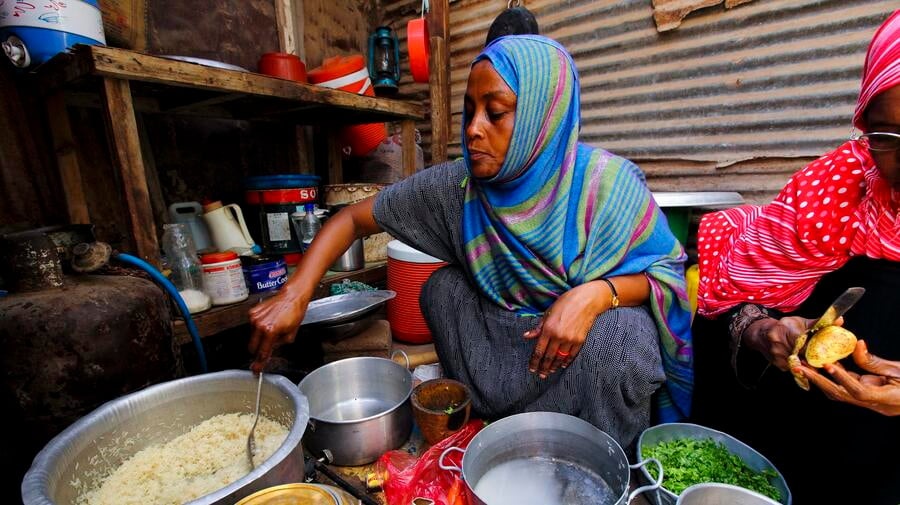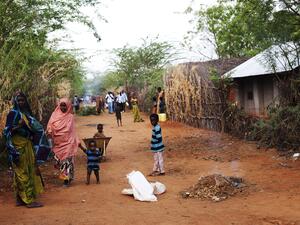Almost 320,000 civilians flee Somalia this year, including 20,000 to Yemen
Almost 320,000 civilians flee Somalia this year, including 20,000 to Yemen

A Somali refugee cooks a meal for her family in Yemen.
GENEVA, October 21 (UNHCR) - The deteriorating humanitarian situation in Somalia has forced almost 320,000 Somalis to flee their country so far this year. "While the majority are seeking safety and aid in neighbouring Kenya and Ethiopia, many Somalis continue to head northwards to embark on the risky sea journey across the Gulf of Aden," UNHCR spokesman Andrej Mahecic told journalists in Geneva on Friday.
He added that 20,000 new Somali refugees had reached Yemen since the beginning of the year. "In Yemen's reception centres, new arrivals have been telling our staff that drought, famine, conflict and forced conscription are the main reasons for their flight from Somalia," he said.
The increased influx is adding pressure on Yemen and the UN refugee agency. Between January and July, Somali arrivals averaged 1,600 people per month; the numbers increased to 4,500 in August and 3,290 in September - this despite unrest in Yemen. An estimated 196,000 Somali refugees are now in Yemen, where UNHCR's resources are additionally strained by internal displacement that affects more than 415,000 people.
"The worsening security is making our work more dangerous and complex," Mahecic said in Geneva. Fighting in Yemen's Abyan governorate means that transporting new arrivals from reception centres along the Gulf of Aden coast to the Kharaz refugee camp has become increasingly difficult.
UNHCR's award-winning implementing partner, the Society for Humanitarian Solidarity, is now obliged to take a longer route to reach the reception centres to avoid the fighting and to reduce the frequency of convoys between the reception centres and Kharaz. UNHCR is informing new arrivals in the reception and transit centres about the current situation in Yemen and the potential risks. However, many choose not to wait and set off on foot, through conflict-affected areas.
Most new arrivals tell UNHCR that they were unaware of the situation in Yemen and the conditions they would be facing. Many left Somalia hoping they would be able to carry on to other Gulf countries or find work in Yemen. However, the deteriorating security situation has curtailed their movement, and work opportunities for refugees in Yemen are rapidly shrinking.
For these reasons some of the refugees are now considering returning to Somalia. UNHCR has a voluntary repatriation programme but only to the relatively stable northern regions of Puntland and Somaliland for refugees originating from there. However, most Somalis in Yemen are from the volatile southern and central parts of Somalia. The number of other nationals, mainly Ethiopians, arriving in the country has also increased.
The instability in Yemen is also giving greater opportunity for human traffickers and smugglers along the Red Sea coast. Reports of abductions of migrants or refugees upon arrival in Yemen persist - mostly for ransom or extortion. While the main targets seem to be Ethiopian migrants looking for opportunities in Gulf countries, some Somali nationals have also been abducted.
Mahecic said insecurity often prevented patrolling humanitarian teams from reaching the new arrivals before the smugglers. "Another worrying trend has been the prevalence of abuse and sexual assaults of female refugees and migrants while at sea," he said, adding: "Together with our partners we are providing medical assistance and counselling to survivors. Information is also shared with Yemeni police for follow-up."
Meanwhile, the number of Somali refugees arriving at the sprawling refugee complex of Dadaab in north-east Kenya has been dropping sharply. "This could be due to the border military operations or the onset of heavy rains in the area. No newly-arriving refugees have approached the registration centre in the last week," UNHCR's Mahecic said.
Following a grave security incident in Dadaab last week, UNHCR and partner agencies have been continuing life-saving work for hundreds of thousands of refugees. "Our staff and more than 30 partners remain operational in Dadaab's three camps - Ifo, Dagahaley and Hagadera - as well as the new sites of Ifo 2, and Kambioos," Mahecic said.
Together with the World Food Programme, UNHCR is distributing emergency food rations and relief supplies to recent arrivals. Water trucking to the new sites is continuing, while all three hospitals in Ifo, Dagahaley and Hagadera camps are providing health care to the refugees. Primary schools are being run by teachers recruited among the refugee population in the camps.
UNHCR is working with the Kenyan authorities to urgently deploy more policemen in the camps to enhance security measures for refugees and aid workers alike. Dadaab is the world's biggest refugee complex, with its sprawling camps hosting more than 463,000 refugees. Over 190,000 of them arrived this year after fleeing insecurity and famine in Somalia.




